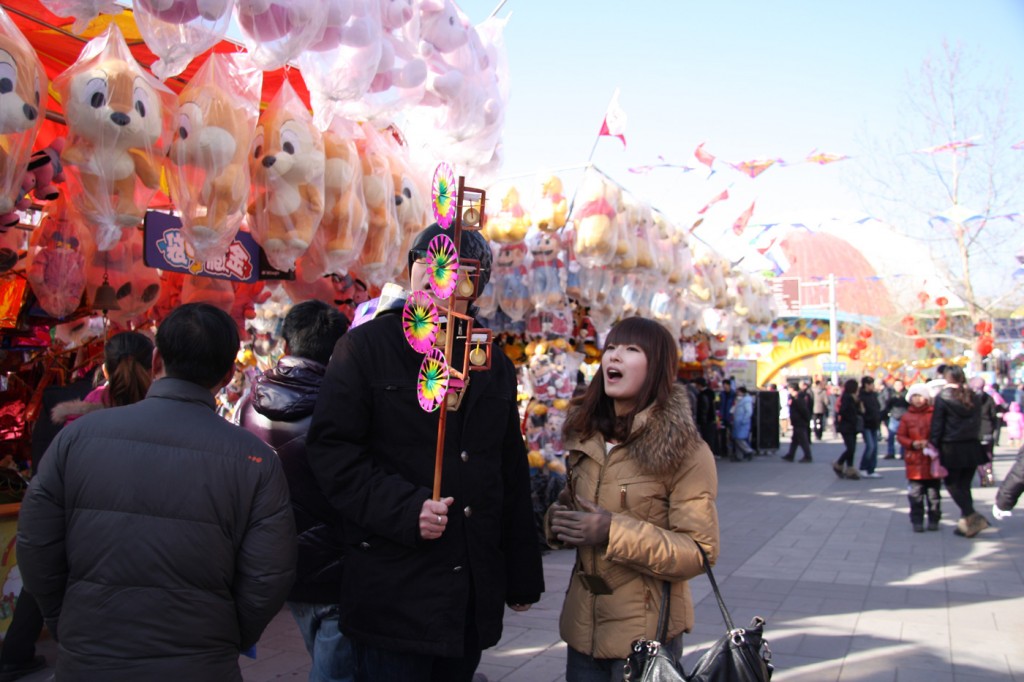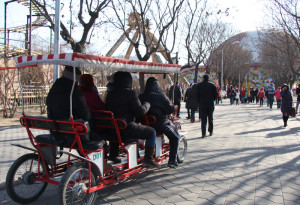
Spring Festival (Chun Jie) brings thousands of people to parks for fun, food, and a sense of tradition. Photo © Shannon Aitken.
China prides itself on its cultural holidays. It’s often hard to keep track of them all—the tomb sweeping festival in early April, which remembers the dead, and the dragon boat festival in June, which requires one to eat sticky rice wrapped in bamboo leaves while thinking of the ancient poet Qu Yuan, are just two of many. But the biggest and most important of them all—as big as Christmas is in the West—is Spring Festival, or, as it’s known locally in Mandarin, Chun Jie. Businesses and local administrators go all out in decorating the streets and buildings, and at night the city is lit by sensational displays of lights—some cheesy, some elegant.Chun Jie celebrates the beginning of the new Chinese year. Like most Chinese holidays, its exact date varies slightly from year to year, depending on the Chinese calendar; it generally starts around late January and runs non-stop for 15 days. In 2014, it will take place from January 31 to February 14.In Beijing, Chun Jie can be either an amazing or a miserable time to visit, depending on your needs or attitude. One of Beijing’s biggest headaches is its population and its consequential strangling traffic. But all that magically disappears for 15 blissful days during Chun Jie. The eight-plus million “temporary” Chinese residents that populate Beijing for work or education for the rest of the year retreat to their hometowns elsewhere in the country, seeking time with family members. As the city empties out, an eerie stillness and fluidity descends on Beijing.
On the plus side, this means that getting around the city is easy and relaxing. Taxi rides are swift and readily available, and tourist sites are often relatively empty.
Unfortunately, many smaller shops or businesses are closed. It’s also a big no-go time to try to travel anywhere else in the country. Trains in particular are likely to be booked solid, and fare-makers take advantage of the “must-get-home frenzy” that takes hold of the populace.
You’ll find there is still plenty going on, though. Large shops and restaurants are busy, and the city becomes animated by the festivities. Businesses and local administrators go all out in decorating the streets and buildings, and at night the city is lit by sensational displays of lights—some cheesy, some elegant.
Most of all, from sun up to well after sun down, locals let loose with fireworks, which, at other times of the year, are strictly regulated inside the inner city. If you dream of times in your own country before fireworks were banned, you can relive childhood memories in Beijing. Fireworks shops suddenly pop up throughout the city along roadsides, and, for 100 yuan (US $16) up to well over 1,000 yuan, you can ignite your own Chun Jie celebration. Just be sure to shop at an approved dealer, which should have an official-looking certificate clearly displayed.
If you’re not keen on risking eye or limb, be sure to at least find your way to a lofty bar or restaurant on the first or final night of Chun Jie by midnight to watch the full eruption of fireworks across the city. Whichever direction you look, the city explodes into fiery flowers.

Riding around Chaoyang Park during Chun Jie.
Photo © Shannon Aitken.
Another must-do for Chun Jie is to seek out a Miao Hui, or a temple fair. These can be found in most of the parks around town throughout the holiday, but the two of the biggest ones include Ditan Park (just by Lama Temple subway station, Lines 2 and 5) and Chaoyang Park. Many like to say Ditan is more traditional, and that’s somewhat true because the park itself has historic and spiritual importance. But it’s also so chokingly crowded that even the proverbial sardine would find it a challenge to have a good time. Chaoyang Park is much larger and, rather than being pressed shoulder to shoulder with thousands of other visitors, you can stroll freely around the park, enjoying the people-watching, snacking on endless food options, and even trying your luck at some carnival games.
Finally, be sure to bundle up if you visit during Chun Jie. Despite hailing the arrival of spring, Chun Jie is often an achingly chilly period that demands level-three coats, gloves, and hats. Forgetting these would not only diminish your ability to enjoy a Miao Hui, but it might also discourage you from skating or pedalling your way around the frozen Houhai lake on a converted bicycle—a silly Chun Jie experience that could be the icing on your visit to Beijing.
